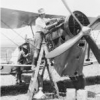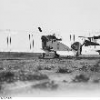The Australian Flying Corps in the Middle East
Australia was the only dominion of the British Empire to establish a flying corps in the First World War.
The first airmen Australia contributed to the war did not fly was part of the corps. Referred to as the Mesopotamian Half Flight, four officers, 41 men and a transport joined British forces fighting Turkey in the Mesopotamian campaign, primarily to help defend the Anglo-Persian oil pipeline and the Persian Gulf. The airmen were caught up in the British advance on Baghdad but instead were besieged by Turkish forces in the city of Kut in modern-day Iraq. The entire force was captured with the fall of Kut and the Australian airmen along with their British compatriots (including Indian troops) went into captivity.
No. 1 Squadron, formed shortly after the Mesopotamian Half Flight, flew in the Sinai and Palestine Campaign supporting ground forces through reconnaissance and bombing enemy targets and fighting German pilots in the skies. It was the first Australian Flying Corps squadron to fight in the First World War. Nos 2, 3 and 4 Squadrons fought in the skies over the Western Front.

The incident for which Lieutenant F.H. McNamara was awarded the VC by the official war artist, Harold Septimus Power. Official war artists were commissioned by the Army or, later, the Australian War Memorial, as part of the Official War Art Scheme (ART08007 courtesy of the Australian War Memorial).

Mechanics of the 1st Squadron, of the Australian Flying Corps, overhauling a Bristol Fighter aeroplane with the fuselage unlaced and engine cowl down (B02213 and text courtesy of the Australian War Memorial).

A Bristol F2B Fighter of the No. 1 Squadron, Australian Flying Corps (B01589 and text courtesy of the Australian War Memorial).
Did you know……
An airman, Francis McNamara, won a Victoria Cross during the Sinai and Palestine Campaign, the highest award in the British Military.
McNamara was returning from a bombing raid on Gaza when he saw a fellow pilot, Captain Douglas Rutherford, had crash-landed his plane. Even worse, he could see Turkish cavalry racing to capture Rutherford. McNamara, who was wounded by shrapnel from the bombing raid at the time, landed in difficult terrain to rescue the Australian pilot. As there was no space for Rutherford in the single seat cockpit, he was forced to climb the wing and hang on to the strut. Partly because of his wound and the fact the plane was unbalanced, McNamara crashed the plane.
The two pilots raced back to Rutherford’s downed plane and McNamara repaired the engine while Rutherford held off the Turkish cavalry with his pistol and two other places from No.1 Squadron strafed the enemy. McNamara was able to repair the engine and the two pilots escaped in the nick of time. McNamara and Rutherford successfully made it back to the base of El Arish despite McNamara suffering from substantial blood loss. McNamara was the first Australian aviator to receive the Victoria Cross.

